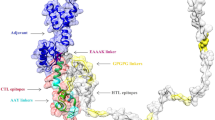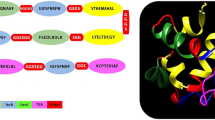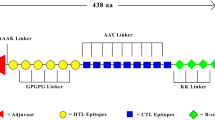Abstract
Kala-azar or visceral leishmaniasis (VL) is the most important vector-borne protozoan disease and a life-threatening problem in the globe due to the lack of ideal vaccines or drugs. Recent advances in immunoinformatics and bioinformatics could be a promising approach in designing a new recombinant vaccine for VL treatment. In this study, a new recombinant vaccine against Leishmania infantum (L. infantum) designed by the computational method and Gp63, Hsp70 and Kmp11 antigens from L. infantum were selected as potential immunodominant epitopes. RpfE and RpfB from Mycobacterium tuberculosis used as adjuvants for enhancing vaccine immunogenicity. bioinformatic tools were used to analyze different aspects of the designed vaccine including, protein–protein interactions, B cell epitopes, MHC class I and II epitopes, the amino acid composition of multi-epitope vaccine, immunogenic behavior, and 3D homology modeling. This study revealed that our designed recombinant vaccine is able to induce responses of the immune system against L. infantum, and may be helpful to control VL infection, after appropriate in vitro and in vivo immunological assays.




Similar content being viewed by others
References
Agallou M, Margaroni M, Karagouni E (2011) Cellular vaccination with bone marrow-derived dendritic cells pulsed with a peptide of Leishmania infantum KMP-11 and CpG oligonucleotides induces protection in a murine model of visceral leishmaniasis. Vaccine 29:5053–5064
Akhtari J, Soosaraei M, Ziaei H, Fakhar M (2017) Last decade developments on leishmania vaccines with emphasis on nanovaccines. J Mazandaran Univ Med Sci 26:232–253
Ambrose M, Gatti RA (2013) Pathogenesis of ataxia-telangiectasia: the next generation of ATM functions. Blood 121:4036–4045
Argos P (1990) An investigation of oligopeptides linking domains in protein tertiary structures and possible candidates for general gene fusion. J Mol Biol 211:943–958
Carrillo E et al (2008) Immunogenicity of HSP-70, KMP-11 and PFR-2 leishmanial antigens in the experimental model of canine visceral leishmaniasis. Vaccine 26:1902–1911
Castro Neto AL, Brito A, Rezende AM, Magalhaes FB, de Melo Neto OP (2019) In silico characterization of multiple genes encoding the GP63 virulence protein from Leishmania braziliensis: identification of sources of variation and putative roles in immune evasion. BMC Genom 20:118. https://doi.org/10.1186/s12864-019-5465-z
Catta-Preta CM, Mottram JC (2018) Drug candidate and target for leishmaniasis. Nature Publishing Group, London
Chen X, Zaro JL, Shen W-C (2013) Fusion protein linkers: property, design and functionality. Adv Drug Deliv Rev 65:1357–1369
Coffman RL, Sher A, Seder RA (2010) Vaccine adjuvants: putting innate immunity to work. Immunity 33:492–503
Colovos C, Yeates TO (1993) Verification of protein structures: patterns of nonbonded atomic interactions. Protein Sci 2:1511–1519
De Groot AS, Moise L, McMurry JA, Martin W (2009) Epitope-based Immunome-derived vaccines: a strategy for improved design and safety. Clinical applications of immunomics. Springer, Berlin, pp 39–69
de Oliveira LMF et al (2015) Design, immune responses and anti-tumor potential of an HPV16 E6E7 multi-epitope vaccine. PLoS ONE 10:e0138686
Dias DS et al (2018) Recombinant prohibition protein of Leishmania infantum acts as a vaccine candidate and diagnostic marker against visceral leishmaniasis. Cell Immunol 323:59–69
Dimitrov I, Naneva L, Doytchinova I, Bangov I (2013) AllergenFP: allergenicity prediction by descriptor fingerprints. Bioinformatics 30:846–851
Dimitrov I, Bangov I, Flower DR, Doytchinova I (2014) AllerTOP v2: a server for in silico prediction of allergens. J Mol Model 20:2278
Doytchinova IA, Flower DR (2007) VaxiJen: a server for prediction of protective antigens, tumour antigens and subunit vaccines. BMC Bioinform 8:4
Duthie MS, Windish HP, Fox CB, Reed SG (2011) Use of defined TLR ligands as adjuvants within human vaccines. Immunol Rev 239:178–196
Emini EA, Hughes JV, Perlow D, Boger J (1985) Induction of hepatitis A virus-neutralizing antibody by a virus-specific synthetic peptide. J Virol 55:836–839
Esboei BR, Mohebali M, Mousavi P, Fakhar M, Akhoundi B (2018) Potent antileishmanial activity of chitosan against Iranian strain of Leishmania major (MRHO/IR/75/ER): in vitro and in vivo assay. J Vector Borne Dis 55:111
Foroutan M, Ghaffarifar F, Sharifi Z, Dalimi A, Pirestani M (2018) Bioinformatics analysis of ROP8 protein to improve vaccine design against Toxoplasma gondii Infection. Genet Evol 62:193–204
Gasteiger E, Hoogland C, Gattiker A, Wilkins MR, Appel RD, Bairoch A (2005) Protein identification and analysis tools on the ExPASy server. The proteomics protocols handbook. Springer, Berlin, pp 571–607
González-Galarza FF et al (2014) Allele frequency net 2015 update: new features for HLA epitopes, KIR and disease and HLA adverse drug reaction associations. Nucleic Acids Res 43:D784–D788
Grote A, Hiller K, Scheer M, Münch R, Nörtemann B, Hempel DC, Jahn D (2005) JCat: a novel tool to adapt codon usage of a target gene to its potential expression host. Nucleic Acids Res 33:W526–W531
He J, Huang F, Li J, Chen Q, Chen D, Chen J (2019) Bioinformatics analysis of four proteins of Leishmania donovani to guide epitopes vaccine design and drug targets selection. Acta Trop 191:50–59
Hebditch M, Carballo-Amador MA, Charonis S, Curtis R, Warwicker J (2017) Protein–sol: a web tool for predicting protein solubility from sequence. Bioinformatics 33:3098–3100
Heo L, Park H, Seok C (2013) GalaxyRefine: protein structure refinement driven by side-chain repacking. Nucleic Acids Res 41:W384–W388
Jensen LJ et al (2005) STRING: known and predicted protein-protein associations, integrated and transferred across organisms. Nucleic Acids Res 33:D433–437
Karplus P, Schulz G (1985) Prediction of chain flexibility in proteins. Naturwissenschaften 72:212–213
Khatoon N, Pandey RK, Prajapati VK (2017) Exploring Leishmania secretory proteins to design B and T cell multi-epitope subunit vaccine using immunoinformatics approach. Sci Rep 7:8285
Kim JS et al (2013) Mycobacterium tuberculosis RpfB drives Th1-type T cell immunity via a TLR4-dependent activation of dendritic cells. J Leukoc Biol 94:733–749
Kolaskar A, Tongaonkar PC (1990) A semi-empirical method for prediction of antigenic determinants on protein antigens. FEBS Lett 276:172–174
Krieger E, Koraimann G, Vriend G (2002) Increasing the precision of comparative models with YASARA NOVA: a self-parameterizing force field. Protein 47:393–402
Kumar R, Engwerda C (2014) Vaccines to prevent leishmaniasis. Clin Transl Immunol 3:e13
Kumar S, Sunagar R, Gosselin EJ (2019) Bacterial protein toll-like-receptor agonists: a novel perspective on vaccine adjuvants. Front Immunol 10:1144
Larsen JEP, Lund O, Nielsen M (2006) Improved method for predicting linear B-cell epitopes. Immunome Res 2:2
Le-Barillec K, Magalhaes JG, Corcuff E, Thuizat A, Sansonetti PJ, Phalipon A, Di Santo JP (2005) Roles for T and NK cells in the innate immune response to Shigella flexneri. J Immunol 175:1735–1740
Lovell SC et al (2003) Structure validation by Cα geometry: ϕ, ψ and Cβ deviation. Proteins 50:437–450
Lüthy R, Bowie JU, Eisenberg D (1992) Assessment of protein models with three-dimensional profiles. Nature 356:83
Magnan CN, Randall A, Baldi P (2009) SOLpro: accurate sequence-based prediction of protein solubility. Bioinformatics 25:2200–2207
Magnan CN, Zeller M, Kayala MA, Vigil A, Randall A, Felgner PL, Baldi P (2010) High-throughput prediction of protein antigenicity using protein microarray data. Bioinformatics 26:2936–2943
Mahendran R, Jeyabaskar S, Sitharaman G, Michael RD, Paul AV (2016) Computer-aided vaccine designing approach against fish pathogens Edwardsiella tarda and Flavobacterium columnare using bioinformatics softwares. Drug Des Dev Therapy 10:1703
Mazumder S, Maji M, Das A, Ali N (2011) Potency, efficacy and durability of DNA/DNA, DNA/protein and protein/protein based vaccination using gp63 against Leishmania donovani in BALB/c mice. PLoS ONE 6:e14644
Minhas V, Shrestha A, Wadhwa N, Singh R, Gupta SK (2016) Novel sperm and gonadotropin-releasing hormone-based recombinant fusion protein: achievement of 100% contraceptive efficacy by co-immunization of male and female mice. Mol Reprod Dev 83:1048–1059
Olivier M, Atayde VD, Isnard A, Hassani K, Shio MT (2012) Leishmania virulence factors: focus on the metalloprotease GP63. Microbes Infect 14:1377–1389
Orr MT, Beebe EA, Hudson TE, Moon JJ, Fox CB, Reed SG, Coler RN (2014) A dual TLR agonist adjuvant enhances the immunogenicity and protective efficacy of the tuberculosis vaccine antigen ID93. PLoS ONE 9:e83884
Parker J, Guo D, Hodges R (1986) New hydrophilicity scale derived from high-performance liquid chromatography peptide retention data: correlation of predicted surface residues with antigenicity and X-ray-derived accessible sites. Biochemistry 25:5425–5432
Peters B et al (2005) The design and implementation of the immune epitope database and analysis resource. Immunogenetics 57:326–336
Rafati S, Gholami E, Hassani N, Ghaemimanesh F, Taslimi Y, Taheri T, Soong L (2007) Leishmania major heat shock protein 70 (HSP70) is not protective in murine models of cutaneous leishmaniasis and stimulates strong humoral responses in cutaneous and visceral leishmaniasis patients. Vaccine 25:4159–4169
Rasti S, Ghorbanzadeh B, Kheirandish F, Mousavi SG, Pirozmand A, Hooshyar H, Abani B (2016) Comparison of molecular, microscopic, and culture methods for diagnosis of cutaneous leishmaniasis. J Clin Lab Anal 30:610–615
Reed SG, Coler RN, Campos-Neto A (2003) Development of a leishmaniasis vaccine: the importance of MPL. Expert Rev Vaccines 2:239–252
Reed SG, Hsu F-C, Carter D, Orr MT (2016) The science of vaccine adjuvants: advances in TLR4 ligand adjuvants. Curr Opin Immunol 41:85–90
Saha S, Raghava G (2006) AlgPred: prediction of allergenic proteins and mapping of IgE epitopes. Nucleic Acids Res 34:W202–W209
Silva DTD, Alves ML, Spada JCP, Silveira R, Oliveira T, Starke-Buzetti WA (2018) Neutrophils, eosinophils, and mast cells in the intestinal wall of dogs naturally infected with Leishmania infantum. Braz J Vet Parasitol 27:430–438. https://doi.org/10.1590/s1984-296120180085
Solana JC et al (2017) Vaccination with a Leishmania infantum HSP70-II null mutant confers long-term protective immunity against Leishmania major infection in two mice models. PLoS Negl Trop Dis 11:e0005644
Stevanovic S et al (2018) In silico discovery of a substituted 6-methoxy-quinalidine with Leishmanicidal activity in Leishmania infantum. Molecules (Basel, Switzerland). https://doi.org/10.3390/molecules23040772
Takamatsu N, Watanabe Y, Yanagi H, Meshi T, Shiba T, Okada Y (1990) Production of enkephalin in tobacco protoplasts using tobacco mosaic virus RNA vector. FEBS Lett 269:73–76
Thomas MC, Garcia-Perez JL, Alonso C, Lopez MC (2000) Molecular characterization of KMP11 from Trypanosoma cruzi: a cytoskeleton-associated protein regulated at the translational level. DNA Cell Biol 19:47–57. https://doi.org/10.1089/104454900314708
Uliana SR, Trinconi CT, Coelho AC (2018) Chemotherapy of leishmaniasis: present challenges. Parasitology 145:464–480
Wang P, Sidney J, Dow C, Mothe B, Sette A, Peters B (2008) A systematic assessment of MHC class II peptide binding predictions and evaluation of a consensus approach. PLoS Comput Biol 4:e1000048
Wiederstein M, Sippl MJ (2007) ProSA-web: interactive web service for the recognition of errors in three-dimensional structures of proteins. Nucleic Acids Res 35:W407–W410
Yang J, Yan R, Roy A, Xu D, Poisson J, Zhang Y (2015) The I-TASSER suite: protein structure and function prediction. Nat Methods 12:7
Author information
Authors and Affiliations
Corresponding author
Ethics declarations
Conflict of interest
All authors declare that they have no conflict of interest.
Ethical Approval
This article does not contain any studies with human participants or animals performed by any of the authors.
Additional information
Publisher's Note
Springer Nature remains neutral with regard to jurisdictional claims in published maps and institutional affiliations.
Rights and permissions
About this article
Cite this article
Hashemzadeh, P., Ghorbanzadeh, V., Lashgarian, H.E. et al. Harnessing Bioinformatic Approaches to Design Novel Multi-epitope Subunit Vaccine Against Leishmania infantum. Int J Pept Res Ther 26, 1417–1428 (2020). https://doi.org/10.1007/s10989-019-09949-6
Received:
Revised:
Accepted:
Published:
Issue Date:
DOI: https://doi.org/10.1007/s10989-019-09949-6




